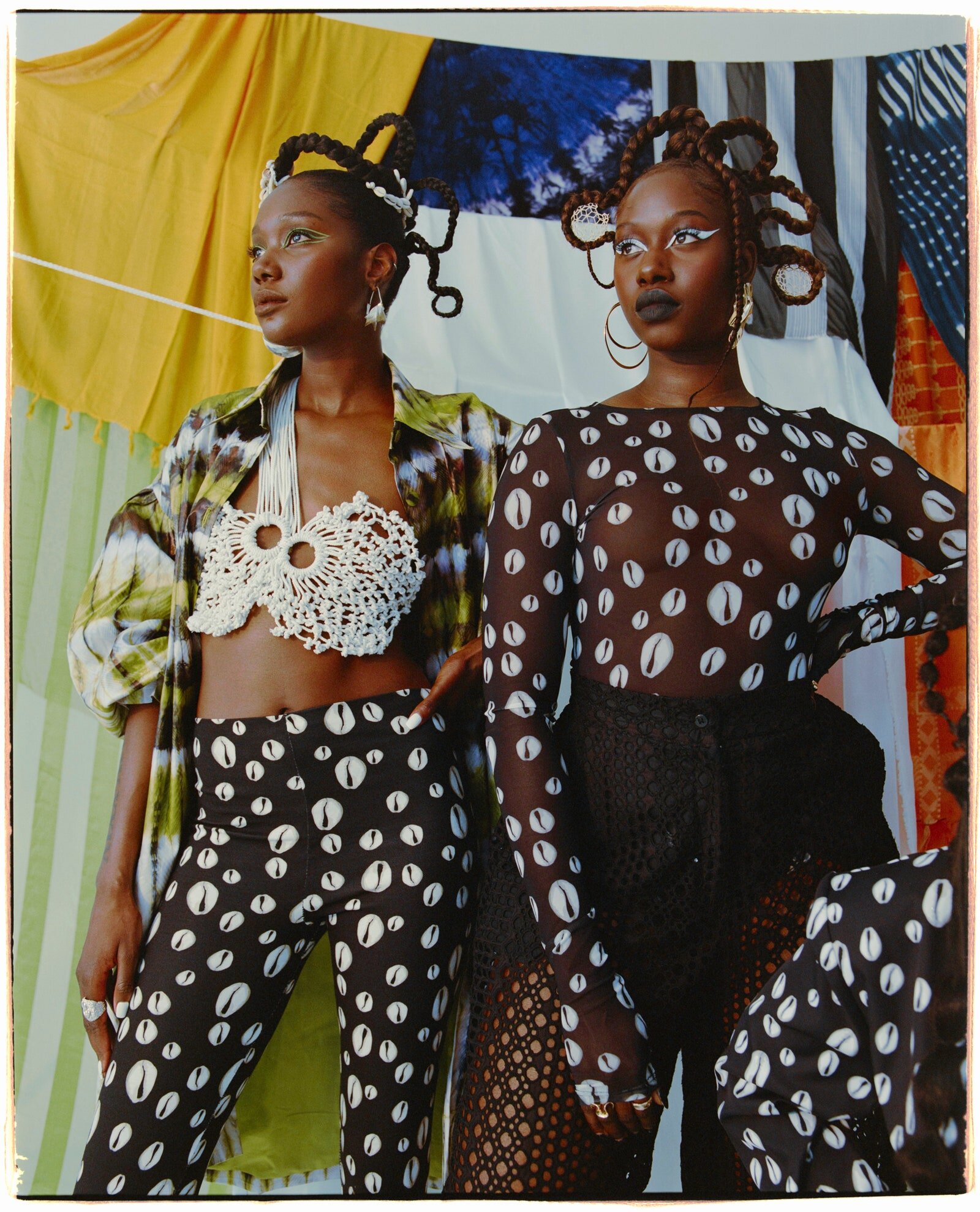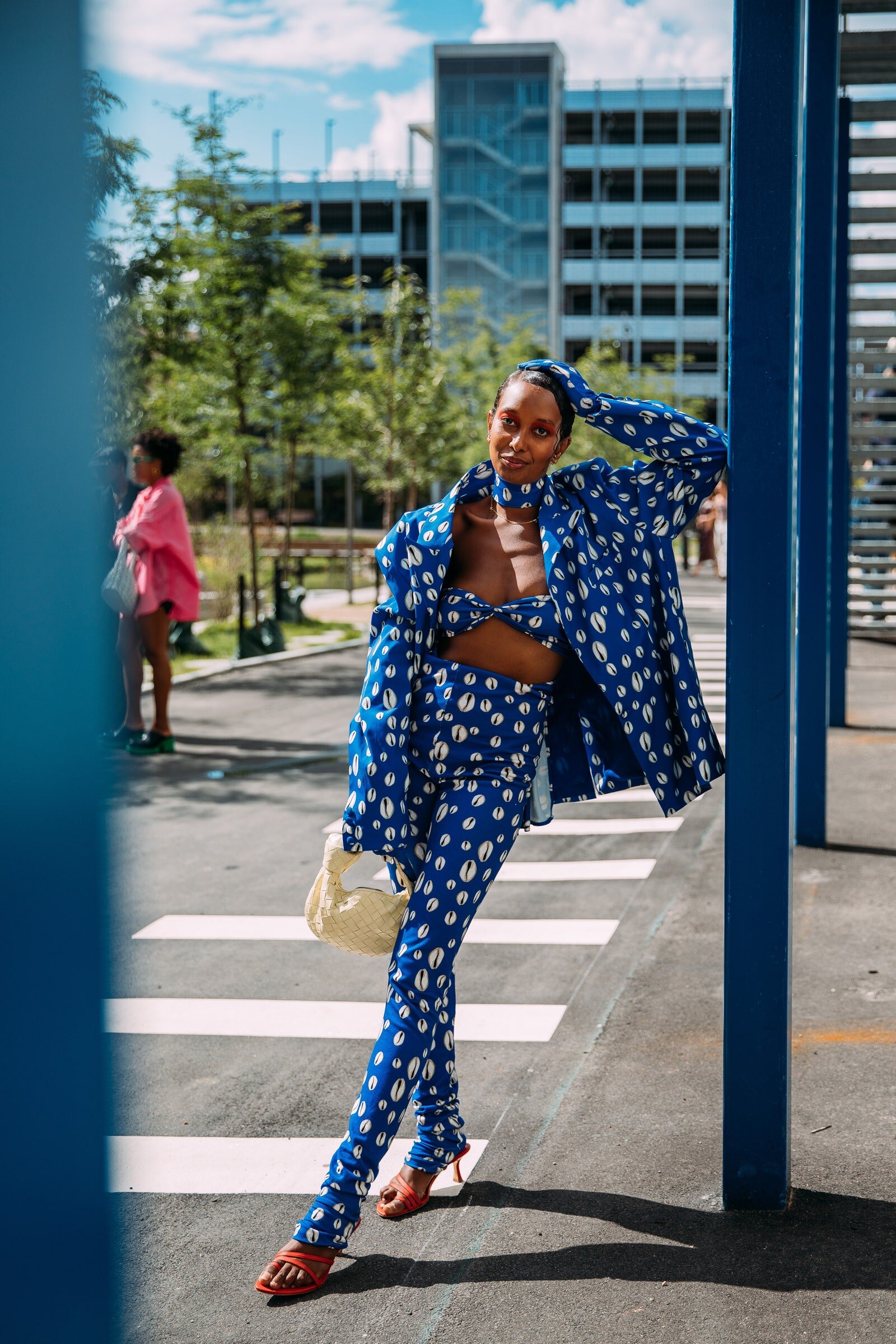AAJIYA DESIGNER MAIMUNA COLE IS DREAMING BIG
Aajiya’s Pétaw collection.
Photo: Pauline Suzor @suzor / Courtesy of Aajiya
Among the most striking looks to appear at Copenhagen Fashion Week were cowrie-print separates from Aajiya, a Stockholm-based brand founded by Maimuna Cole. Born in Sweden with Gambian roots, Cole says she’s designing with a higher purpose (or two or three). She’d like to raise the profile of Africans in fashion, and hopes to contribute to the infrastructure of West Africa by moving her business there at some point. In the meantime, she’s busy building her own universe and filling it with colorful prints and romantic openwork dresses that are attracting a growing fan base that includes Seinabo Sey, Sabina Ddumba, and Gabrielle Union.
Here, Cole talks to Vogue Runway about her influential grandmother (for whom the line is named), the struggles she faces as a Black designer, and some of the people who inspire her.
Aajiya’s Pétaw collection.
Photo: Pauline Suzor @suzor / Courtesy of Aajiya
Aajiya’s Pétaw collection.
Photo: Pauline Suzor @suzor / Courtesy of Aajiya
When did you first become interested in fashion?
Where it all started was when I moved to Gambia when I was 10 years old, and I lived with my uncle and my grandmother. They have a huge atelier there, and every day they’re sewing from the morning to night. I would see my grandmother taking the leftover fabrics and putting them together, and I always felt it was very cool. She was such a creative woman and really inspiring to me, so I would also just take the pieces from here and there [and try] to make a top or skirt or whatever.
Mona Ali in Aajiya.
Photographed by Acielle / StyleDuMonde
Amelia Hoy in an Aajiya top and A. Roege Hove sweater.
Photographed by Acielle / StyleDuMonde
How did you start your business?
I started the concept of Aajiya when I was 16, and I’m 27. I was 16 when I moved back to Sweden, [and] I began small projects here and there. My first [one] was batik blazers, and the response from that [was such that], I was like, Okay, maybe I’m good at this, so let me just start to do it. So I [did], but then I felt like I was lacking the business part of it. So I studied business management. After that, I was like, Now I feel like I’m kind of ready, but how do you start? Where do I go? Who do I connect with? So I went to Senegal for six months and created a collection, my first, which Seinabo Sey wore at Way Out West [in 2019], and that became my viral moment. And that’s when I was like, You know what? I’m going to do this as a career.
What challenges did you face?
[After that I was] just kind of like, Do I want to stay here in Sweden? Because I never felt like I belonged in Sweden. I’ve never been comfortable. Growing up, I felt like I was always the outsider. I always felt like I was different, the only Black girl in the classroom. [In fashion], it felt as if there was no door for us at all, like there was nowhere for us to turn, so we had to just move out of here. It’s like, you guys don’t want us to be part of this. We’re never invited to events; even internships are a problem. [I was like,] If you don’t want to open the door for me, I’ll make sure to build my own door. Honestly, it’s sad that you have to leave your own home, your own country, to go somewhere else where you’re appreciated. [In Stockholm] it’s more like, Oh, we have our own circle; let’s stick with that. It’s been like that for years, and it’s not working so far because they haven’t really advanced in the fashion spectrum. If you look at America or England, everything is so diverse, things are happening, but here it’s just flatlined.
I can speak for a lot of Black people here, creatives; we always have to adapt. My story is I had to change my name to Maya because people couldn’t pronounce my name. It’s like, I’m losing my identity to adapt to you. I shouldn’t have to do that. You always have to adapt and it always feels like you don’t belong here. They speak English when they see you. And it’s like, No, I speak Swedish. Or it’s like, “How long have you been here?” No, I was born here. Why does it always have to be that conversation? And it’s daily all the time. I just don’t care anymore; I’m creating my own little bubble and if you want to come, you can come get some knowledge, some culture, some stories, so you can feel where I come from through my clothes.
Aajiya’s Pétaw collection.
Photo: Pauline Suzor @suzor / Courtesy of Aajiya
Do you have any role models?
Selam [Fessahaye] honestly opened the doors for us. I can say that because she definitely made me feel like I can do this too, being a woman and being from East Africa. I was like, Oh, my God, she really did this. And she did not care. She did that. She had the big silhouettes, the colors—everything; it was so, so amazing. And for me, that really inspired me to also just not give a shit, basically.
Do you feel more comfortable in Sweden now?
I honestly had to create my own worlds and that is why my clothes are so loud—prints, colors…. This is who I am and I’m not afraid to own my space.
Aajiya’s Pétaw collection.
Photo: Pauline Suzor @suzor / Courtesy of Aajiya
How do your Swedish and African roots meet in your work?
[My work] is basically a description of me. I come from two worlds, and I’m putting that together and just creating strength through that. That’s the simplest way for me to explain it. And also African fashion has been so downplayed, and I just want Africans to take space in the fashion industry. It’s coming, it’s coming, but I’m taking my steps as well [to] be part of African fashion, to lift it up and [to] be more mainstream [so] you can go everywhere and [it’s] not just like a costume, so it’s beautiful. And I’m so excited for this.
Aajiya’s Pétaw collection.
Photo: Pauline Suzor @suzor / Courtesy of Aajiya
Can you tell me about the cowrie print in your latest collection?
For me [this collection] was an introduction of who I am, where I come from. And the cowrie shell has been so commercialized that the history of it has been kind of lost. So for me it was [like], Let me take that back and educate people and also wear it as armor. It’s just a luxury feel when you know the history of it. In Africa, it was the first currency before the colony, and for me, it was like, this is something rich and also very cool and very authentic, so why not put this as a print and just have loud colors on top of it?
Aajiya’s Pétaw collection.
Photo: Pauline Suzor @suzor / Courtesy of Aajiya
What could the industry do to help you?
I think [it’s] becoming more open to new creatives, a new experience of clothes and not just sticking to just one thing. I’m starting to see that Africans are being more accepted in the fashion industry, like Kenneth Ize. He’s someone who is very inspiring, because he came and had his show in Paris, which was amazing, with fabrics that were made in Africa. That’s what I want to be. I just want people to accept what I’m making, and in the near future, I’m going to introduce other fabrics, like batik that is handmade. There’s so much luxury in our culture, and I really want to show that to people. As Africans, we wear customized clothes every single time and bring that kind of luxury feel with fabrics that are handmade and sustainable as well.
Aajiya’s Pétaw collection.
Photo: Pauline Suzor @suzor / Courtesy of Aajiya
Aajiya’s Pétaw collection.
Photo: Pauline Suzor @suzor / Courtesy of Aajiya
What do you dream of doing long-term?
My ultimate goal is to have a studio in my home country and bring all the tailors [together]. The thing is, in Africa they’re all self-taught, and they’re lacking skills that could be very good for them if they want to branch out and create their own stuff. My ultimate goal is to have my clothes made in Gambia. I make them in China right now. I want to move everything here, make all this stuff in Sweden. And then once I feel like I’m stable enough, I can go to Gambia, back and forth, and just make my stuff from there. I really, really want to be part of the infrastructure in Gambia or Senegal. It’s a higher purpose, it really is. It’s not just to sell clothes or whatever; it’s to bring awareness to Africa, how creative they are, how sustainable they are really, because most of the things that they do, it’s [with] what they have. It’s a big job to do, but I am very determined.



















What exactly is breathwork and how do you do it?